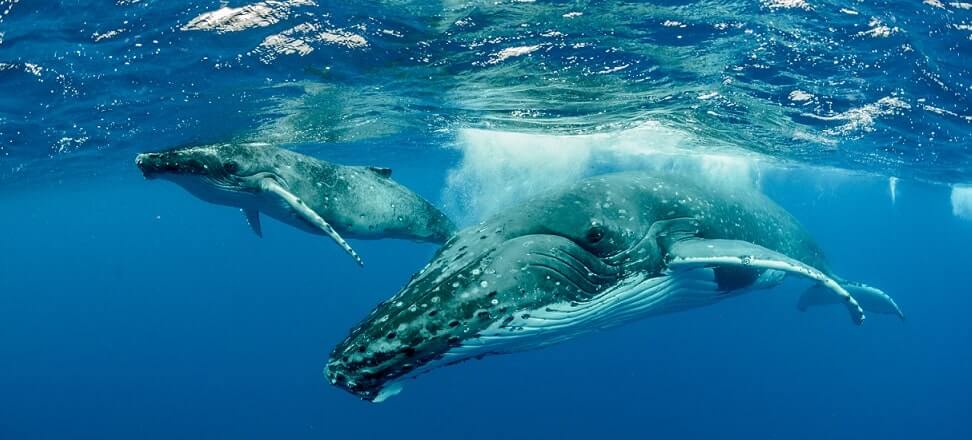Many species of aquatic mammals, including cetaceans, use sound for communication and daily migration, which can be hampered by noise pollution. But what exactly is it and how does it affect whales and their migrations? We delve into the latest scientific findings to answer these questions.
Noise pollution
Sources of noise can be diverse and accompany us on a daily basis. Whether it’s noisy music at a party, passing cars, verbal communication between crowds of people, or the use of electrical appliances. We speak of the phenomenon of noise pollution when there is excessive exposure of the listener to sounds. The World Health Organization (WHO) has determined that noise pollution begins when a threshold of 65 decibels (dB) is exceeded, however, as little as 30 dB impairs sleep and contributes to hearing complications. Recent studies show that noise exposure is now a serious problem, as the WHO alerts that more than 5 percent of population – about 430 million people – worldwide require rehabilitation to correct hearing loss, and by 2050. This number will increase to 700 million people.
The problem of excessive noise also exists in the water space. Thanks to the development of science, we know that sound travels a greater distance underwater than in the air, which means that signaling information underwater is possible over much greater distances. This benefits many marine mammals that use sound communication. Now, with the advent of the industrial age, aquatic animals are no longer only more exposed to natural ambient noise such as wind, rain and cracking ice, but also to anthropogenic sources of sound, that is, man-made.
Sources of underwater noise are primarily shipping, offshore construction, sonar or equipment exploration. The problem has escalated significantly in recent decades. Since 1950. Noise levels in the ocean have increased by more than 20 decibels, or a 100-fold increase in noise intensity, which has been fueled by, for example, oil exploration and the expansion of construction work at depth.
Sound intensity and cetacean communication
Toothfish, including orcas and dolphins, use short clicks and high-frequency whistles for echolocation and communication with other individuals. Fishbowls and sperm whales, however, unlike the rest of the aquatic mammals, communicate through what is known as cetacean singing. Their acoustic communication is more like singing, similar to human or bird song. Vocalization varies depending on the species involved. Blue fins, for example, are famous for their songs, dwarf fins make a distinctive “buzzing” sound, and belugas, studies have shown, are able to imitate the melody of the human voice. However, the general way cetaceans communicate is still unexplored fully by humans.
Cetacean melodies were first recorded about 50 years ago, and research on whale singing has been carried out ever since. They showed that these chants play a key role in social communication and determine the reproductivity of these mammals. This is why anthropogenic noise sources can be so dangerous to their existence. This is evidenced by frequent cases of stranded cetaceans due to seismic sounds or stress reactions of whalebones to noise.
Boston’s New England Aquarium has studied the feces of Biscayan whales to monitor their stress hormone output. A study by a team of specialists showed that during a two-day suspension of ship traffic in the analyzed sea area, underwater noise levels decreased by 6 decibels. This significant decrease in noise had a direct effect on reducing the levels of stress hormones in these animals.
Latest research – impact of noise on whale migrations
One of the more complex areas of research is the migrations of these marine mammals. Fin whales, included in this group, make large-scale migrations every year, traveling long distances between feeding areas and breeding sites. Individuals have been observed to travel as far as 20,000. km per year. Cetacean singing also plays a role in this process. Through acoustic communication, the whalebone amplifies information about migration routes. In doing so, they take advantage of mass communication, as the transmitted sounds over hundreds of kilometers help isolated individuals navigate and take the correct course.
In recent years, research teams at the University of Melbourne have been examining how noise pollution affects whale migrations. To this end, mathematical models have been developed to study the relationship between signal detection, noise pollution and navigation behavior. Studies have shown that noise from human activities affects cetacean migration through three mechanisms. First, it reduces traffic space, thus increasing the travel time of whaleboaters due to the lower efficiency of mass navigation. Second, animals respond by avoiding noise when noise is above a tolerable threshold, which can block the migration routes in question. Third, it causes confusion among cetaceans, whose ability to identify their surroundings is effectively reduced, leading them to stray off course.
Unfortunately, forecasts are not optimistic, as he expects further growth in shipping activity and larger-scale resource extraction in the future, which will increase noise. Scientists stress the importance of regulating excessive anthropogenic sound sources, not only for the sake of cetaceans, but also for other animal species that feel the presence of noise pollution. To improve the situation, researchers are still trying to learn about the hearing senses of marine animals and set a new direction for technology applied to water. On an optimistic note, this year’s International Maritime Organization (IMO) has announced that it has developed a final version of an action plan to significantly reduce underwater noise generated by ships, as we have already written about inWater Matters.

 Polski
Polski






